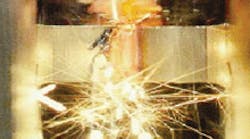Hydraulics at the Core of Largest-Ever Linear-Friction-Welding Machine
Authored by: Key points: • Moog hydraulics permit fast, high-amplitude motion, high flow rates, and quick recharge. • Linear-friction welding forms complex shapes with little or no machining. Resources: Thompson Friction Welding, www.thompson-friction-welding.co.uk |
A welding supplier found that the key to taking its joining technology to the next level lay not in the welding heads, but in a hydraulic servo support system.
Thompson Friction Welding, Halesowen, West Midlands, U.K., developed the E100, a linear-friction-welding (LFW) machine capable of welding a surface area of 15 in.2, twice the area previous machines could weld. The 22,050-lb, 2.5-m-tall machine also applies a record 22,050 lb of force to the joint being welded.
To handle larger, heavier parts and cut cycle times, Thompson teamed with Moog Inc., E. Aurora, N.Y., to develop a hydraulic servocontrol system.
Normal servo and proportional valves aren’t suited for this application because spool speed and acceleration prevent them from simultaneously delivering high amplitude and high-frequency motion. A closed-loop, digital control system, in contrast, delivers fast response at high amplitude, which permits precise control over the weld process.
For the E100, Moog valve spools perform three to four times faster than normal. Valve frequencies range from 75 to 100 Hz for large-scale welding. Special precautions ensure valve integrity over a large number of welds.
Multiple digitally controlled servovalves operate together for peak flow rates of up to 1,200 gpm. Having multiple valves also improves accuracy on smaller, lower-force welds.
To drive the system, a hydraulic powerplant with radial piston pumps delivers over 2 MW of instantaneous power. Seven 105-gallon gas-volume accumulators supplement pump flow to hit the 1,200-gpm flow rates required for the weld. The accumulators recharge in about 30 sec, even for the largest welds.
An automatic handling system positions large workpieces in place of manual fixturing. The automation saves time on these larger parts. Rapid machine opening and closing also cut production time.
LFW, sometimes known as solid-base additive manufacturing, forms complex shapes without the waste associated with machining from solid block, casting, or forging. Manufactured parts require little final machining.
The process joins two parts of any shape by laterally oscillating a chuck holding one workpiece with respect to the joining piece. The relative velocity between the two surfaces is fairly high, so the two components being welded need to be kept under high pressure at all times.
In contrast, rotary-friction welding, also known as inertial welding, spins one of the joining pieces, so the two parts must be radially symmetric. LFW requires more complex machine architecture and control systems than rotary techniques.
About the Author
Jessica Shapiro
Jessica serves as Associate Editor - 3 years service, M.S. Mechanical Engineering, Drexel University.
Work experience: Materials engineer, The Boeing Company; Primary editor for mechanical and fastening & joining.
